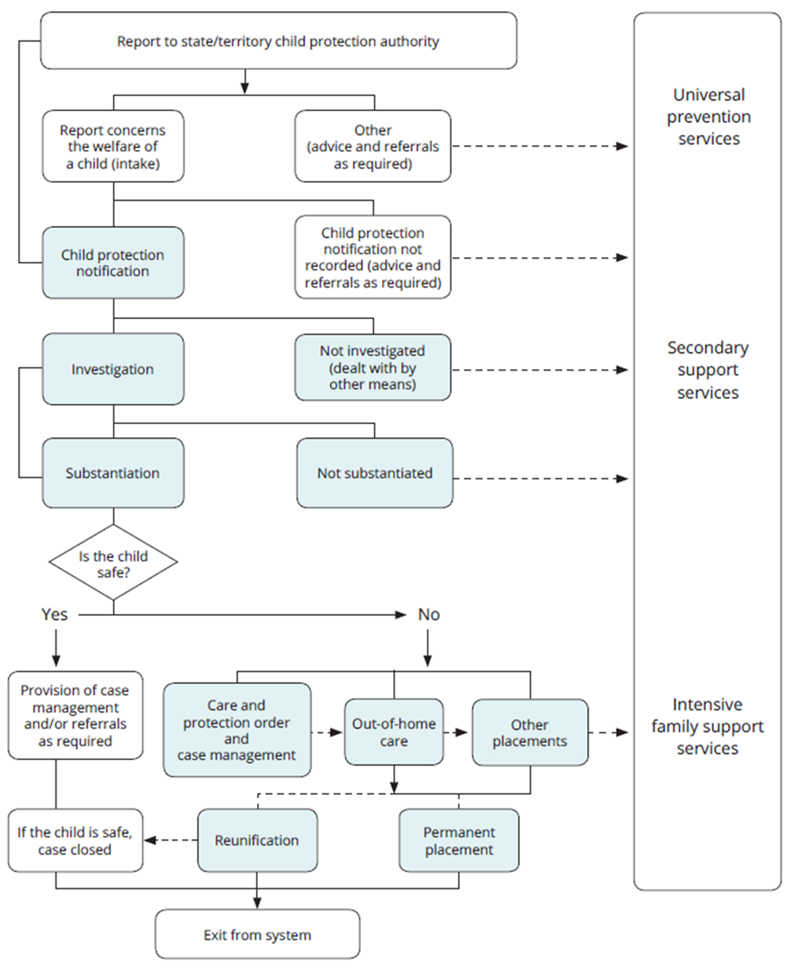How does child protection work in Australia?
In Australia, state and territory governments are responsible for statutory child protection. Each responsible department assists vulnerable children who have been, or are at risk of being, abused, neglected, or otherwise harmed, or whose parents are unable to provide adequate care or protection.
Children and their families come into contact with the child protection system during the investigation and case management of child harm reports. This process may lead to legal intervention to remove a child, or referral to a variety of support services.
Several government and non-government organisations share a common duty of care towards the protection of children and young people. Child protection agencies investigate, process, and oversee the management of child protection cases. Children and their families are assisted by being provided with, or referred to, a wide variety of services, generally delivered by non-government organisations who provide family support services.
The national recurrent spending on child protection and out-of-home care was $6.2 billion in 2020–21, a real increase of $285 million (4.8%) on 2019–20. This continues a pattern of increased spending over the past 5‑year periods, averaging an annual increase of about $385 million between 2015–16 and 2020–21 (Steering Committee for the Review of Government Service Provision 2022).
State and territory departments and the Australian Institute of Health and Welfare (AIHW) jointly fund the annual collation, analysis and publication of child protection data. While there are differences in legislation, policy and practice between jurisdictions that can affect the comparability of some data (see Appendix A), the AIHW works with states and territories to have data supplied according to a set of agreed technical specifications which reflects similar processes. A simplified version of these processes and the data supplied by states and territories is shown in Figure 1.1.
Figure 1.1: Child protection processes in Australia
Notes:
- Shaded boxes are items for which data are collected nationally.
- Dashed lines indicate that clients might or might not receive these services, depending on need, service availability, and client willingness to participate in what are voluntary services.
- Support services referred to in the box on the right include family preservation and reunification services provided by government departments responsible for child protection, and other agencies. Children and families move in and out of these services and the statutory child protection system, and might also be in the statutory child protection system while receiving support services.
Children can come into contact with the child protection system in various ways. Anyone concerned about a child’s welfare can report their concern to a responsible department for further action. Reports of concern can be made by community members, professionals (for example, police, school personnel, or health practitioners), the children themselves, their parent(s), or another relative. These reports might relate to abuse and neglect, or to family concerns such as economic problems or social isolation.
Reports of concern are screened to determine whether the situation meets a threshold for further action. The defined threshold for further action varies across jurisdictions, and this can lead to jurisdictional differences in the responses to initial reports. Reports deemed serious enough to require further action are classified as a ‘family support issue’ and referred to support services, or as a ‘child protection notification’ requiring further intervention. National child protection data do not include reports that are not classified as ‘child protection notifications’.
Nationally, the focus of services is increasingly on early intervention and family support services to help prevent families entering or re‑entering the child protection system, and to minimise the need for more intrusive interventions (AIHW 2021; Bromfield & Holzer 2008; Commonwealth of Australia 2021). Most jurisdictions have enacted strategies that help families in a more holistic way, by coordinating service delivery and providing better access to different types of child and family services (Commonwealth of Australia 2021).
Child protection policies and practices are continually being developed by jurisdictions to improve the safety and wellbeing of vulnerable children. While the processes are largely similar, there are key differences that should be considered when comparing data across jurisdictions.
Further details about the national policy context and each jurisdiction’s policy and practice are described in Appendixes A to C.
References
For a full list of references, go to References.


